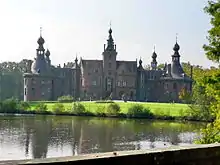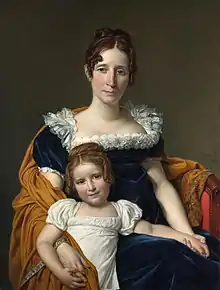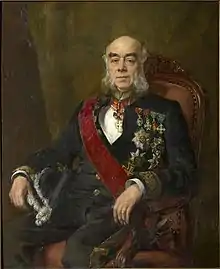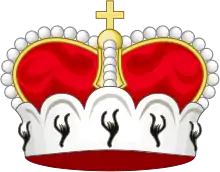Belgian nobility
The Belgian nobility comprises individuals and (some members of) families recognized by the Kingdom of Belgium as members of a certain social class. Historically, these individuals were a socially privileged class enjoying a degree of prestige in society. In contemporary society, much of the historic social privileges associated with being a member of the nobility have become somewhat reduced, reflecting the more egalitarian nature of the present-day.
.jpg.webp)
The Belgian constitution states that no specific privileges are attached to bearing a title of nobility.
History

Because most old families have resided in the current territory of Belgium for centuries and prior to the founding of the modern Belgian state, their members have been drawn from a variety of nations. Spanish nobles resided in Flanders in the 15th and 16th centuries and intermarried with local noble houses. Amongst these houses we find de Peňaranda, Coloma, De Evora y vega, Perez, de Castro y Lopez, de San Estevan, de Horosco, Franco y Feo, Santa Cruz, Gallo de Salamanca, Gerardi, Sant Vittores de la Poitilla.
In the period under Dutch sovereignty, the nobility was an important factor in move towards independence. After independence, the Kingdom of the Netherlands lost an important segment of their nobles, as all of the highest born families lived in the south, and thus became part of the Belgian nobility. At court in the 19th century this new Belgian nobility played a major role.
Male heirs
In some old families the heads of the house have the right of multiple titles. Today, most important families still pass these old titles only in the male line. In the Ancien Régime and Spanish and Austrian period, titles and rights could be inherited by marriage or just by will.
This was legally accepted by the Spanish crown and titles could be accumulated with other legal titles. This system ended after the French Revolution. After the creation of Belgium, families could receive the recognition of their status, which happened for the majority of the current families. Mostly, the noble status was recognized but sometimes the old title could only be passed in the male line of the same noble house. Since this change, old titles have disappeared, and only few old titles survive. Known examples are the counts of Bornhem and the Marquess of Assche titles inherited by the families of Marnix de Sainte-Aldegonde and Vander Noot.
North of France
Until 1662 the North part of France belonged to Flanders, under Spanish rule. Titles created before this date are considered to be part of the Flemish nobility. The Picardian and Artesian nobility lost their land to the French Crown, and was incorporated into the French Kingdom. The Marquess of Morbecque had lost his land after the Battle of Cassel. After this periode much former Flemish houses, were bestowed other French titles.
- examples
- Creation in 1674 by Louis XIV: Marquess of Saint-Floris, title of the Flemish house of Ghistelles.
- Creation in 1705 by Louis XIV: Marquess of Becelaere, title of the Flemish house of de la Woestyne.
Current role of the nobility
During the Austrian period, the high nobility participated in the government, both political and at the imperial court of Brussels. Since the French Revolution the nobility has not played a social function. However some members of most old families worked in major functions in Belgium.
Characteristics




.svg.png.webp)



.JPG.webp)
The modern Belgian nobility is known to be mostly traditionalist, and royalist. In the Kingdom of Belgium there were as of 2013 approximately 1,300 noble families, with some 20,000 members. The noble lineage of only approximately 400 families dates back to the 17th century or earlier. As Belgium is a democratic constitutional monarchy there are no legal privileges attached to bearing a noble title or to being a member of the aristocracy. According to article 113 of the constitution, "The King may confer titles of nobility, without ever having the power to attach privileges to them".[1]
Wealth
Many nobles in Belgium still belong to the elite of society. They sometimes own and manage companies, or have leading positions in cultural society, business, banking, diplomacy, NGOs etc. Many of the older families still own (and reside in) important castles or country houses (see: Castles in Belgium).
The fortune of the nobility is impressive: only 11% of the 500 wealthiest families in Belgium are members of the nobility, however: they have more than 56% of this wealth, 79.85 billion euros.[2] This is partly caused by the fact that many of the new noble titles are bestowed on wealthy entrepreneurs, like the families of Boël, Frere, Colruyt, Janssen and Solvay. Old houses however are in the minority and have sold much of their lands and estates. The house of Merode has sold during the ages thousands of hectares of their own private lands.[3] Other houses have still immense lands and grounds, but most houses have lost much of their historic wealth.
Surname of the House, and division of the families
Like most European nobility, the family name says much of the origin of the house. Normally the name of the family or House cannot change, however it used to be possible. A famous example was Conrad III Schetz: he had himself adopted by his aunt and changed his surname, for him and all his descendants from Schetz to van Ursel.
Every noble family has its own coat of arms and titles: both are legally protected from copyright. People who do not belong to the house, are forbidden to use the titles or the coat of arms.
Legal identity
In Belgium the title forms part of the identity of the noble person and is mentioned on the ID-card. As it is a title, it is not a part of the name.[4]
Assumption of noble titles by those not entitled to any is prohibited and is punishable with a fine of 200 to 1000 euros under article 230 of the Belgian penal code.
Ennoblement
Belgium is one of the few monarchies in the world in which hereditary ennoblement still occurs regularly. Hereditary titles are conferred by letters patent, which are issued by the king of the Belgians, co-signed by the minister of Foreign Affairs. Noble titles can also be granted for life.
Belgian citizens distinguished in business, politics, science, arts, sports, etc. or for extraordinary service to the kingdom may receive noble status or noble titles.
By letters patent extension, change or upgrade of the rank of members of a noble family or change the rank of the whole family.
Structure of the Belgian nobility




_B.jpg.webp)


.jpg.webp)


Characteristically the Belgian nobility is structured and ranked very formally. These ranks are still important in social life and ceremonial life at court.
The royal house does not belong to the Belgian nobility, it is not of Belgian origin and is considered to be above the social class that is the nobility.
Princes in the Belgian nobility
The title of Prince (French: Prince, Dutch: Prins) is the highest noble title in use in Belgium. They are ranked under the princes of royal blood and members of the royal family. New princes are not created, though they can be recognised or incorporated by the king if their members do prove to have bounds in Belgium and live there. This procedure is very rare and has occurred only with princes that de facto are Belgian.
Families
Most members of the families listed below have the right to be referred to in Belgian government documents as "Prince" or "Princess" in combination with their family name. Some titles are not recognised by the Crown, and cannot be used legally, this is the case for the Dukes of Ursel who are the legal heirs to the Prince of Arches and Charleville.
- Former princes
- Prince of Rheina-Wolbeck; former to the House of Looz-Corswarem, at the end given to Napoléon de Lannoy de Clervaux, Prince of Rheina-Wolbeck.The title was recognized by the Belgian Monarch.[5][6]
- Prince Carl of Sweden, Duke of Östergötland (1911–2003), brother of Queen Astrid of Belgium, having wed Countess Elsa von Rosen in 1937 in defiance of Swedish law, forfeited his Swedish succession rights and royal titles; received from his brother-in-law King Leopold III of Belgium the title Prince Bernadotte for life in the Belgian nobility on the same date, Count/ess Bernadotte for his male-line descendants.
- Prince de Béthune-Hesdigneul, princely title descended by male primogeniture; extinct in 1976.
- Current Princes
- Prince Swiatopelk-Czetwertyński, Prince Michel Czetwertynski, Prince Alexandre Czetwertynski, Prince Tinko Czetwertynski recognised in 2007
- Prince de Habsbourg-Lorraine, Archdukes Rudolf (1950) and Carl Christian of Austria (1954), and their legitimate male-line descendants, were incorporated into Belgium's nobility as Prince/sse de Habsbourg-Lorraine in 1978 and 1983, respectively
- Prince of Ligne, Imperial Count 1549, Imperial prince 1601, mediatized 1803, 1923 Belgian recognition of title Prince d'Amblise et d'Epinoy by male primogeniture
- Prince de Lobkowicz, mediatized family of Bohemia whose 1624 Imperial princely title was recognized in Belgium for a member of the family who became a Belgian subject
- Prince de Mérode, Imperial Count since 1622; Heads of the house bore the titles Marquis of Westerlo since 1626 and Prince of Rubempré and Everberg since the 18th century, title of Prince of Grimbergen inherited by primogeniture from Marie-Josephe de Mastaing-Oignies in 1842; each member is prince/sse de Merode since 1929. Famous is prince Emmanuel de Merode, director of the Virunga National Park.
- Riquet, Prince de Chimay in 1824 and Prince de Caraman 1856 by primogeniture; uniquely, since 1889 each male bears the title Prince de Caraman Chimay, while each female born in the family is a countess
- Prince of Waterloo, since 8 July 1815, held by the head of the Wellesley family, the Duke of Wellington.
Dukes in the Belgian nobility
Members of the following houses bear the title of Duke (French: Duc, Dutch: Hertog). The ducal title has never been granted outside the Royal Family in the Kingdom of Belgium. The origin of such titles for Belgian families thus pre-dates the current monarchy, having been conferred or recognised by sovereigns of other jurisdictions.
The title of Duke/Duchess of Brabant (fr: Duc(hesse) de Brabant, nl: Hertog(in) van Brabant, de: Herzog(in) von Brabant) is reserved for the heir apparent to the Belgian monarchy (and in the absence of an heir apparent, the title reverts to the Crown). Current titleholder is Princess Elisabeth.
Examples
- the Duke of Arenberg,[7][8] princely Imperial count 1576, Imperial duke 1644, sovereign 1803-1811, mediatised; although all family members, male and female, are both duke and prince, Belgian recognition of "prince" for all members 1953, Belgian duke by primogeniture, 1994
- the Duke of Beaufort-Spontin,[9] 1746 Austrian Netherlands title of marquis with rank of prince by primogeniture, duke in 1782 and 1876, Imperial Count 1789; family members are Count/ess de Beaufort-Spontin, Head of the House is Duke
- the Duke of Croÿ, Imperial prince 1486, 1594 and 1664, French duke 1598 and 1768; each member is prince/sse de Croÿ, while the Head is also the Duke
- the Duke of Looz-Corswarem et de Corswarem-Looz, 1734 Austrian Netherlands dukedom; mediatised, other members of this ducal branche are prince/sse; members of a second branch are count/ess of Looz-Corswarem; members of a third branche are écuyer de Corswarem
- the Duke of Ursel, Imperial Count 1638. Only the Head of this family is Duke; any other member is count/ess.
Marquesses in the Belgian nobility
Members of twelve families bear today the title of marquess. These titles have origins prior to the French Revolution, and used to be connected to physical marquisates.
In most of these families, the title descends by male primogeniture.
Current marquesses
- the Marquess of Beauffort.
- the Marquess of la Boëssière-Thiennes
- the Marquess of Trazegnies d'Ittre
- the Marquess du Parc.
- the Marquess Imperiali.
- the Marquess of Radiguès.
- the Marquess of Ruffo de Bonneval de la Fare: count of Sinopoli di Calabria
- the Marquess of Spontin, title descends by primogeniture for the Duke of Beaufort Spontin
- the Marquess of Assche, title of the Count van der Noot.
- the Marquess of Yve.
- the Marquess of Westerlo, one of the titles borne by the head of the House of Merode who is fully styled; "Prince de Merode, Marquess of Westerlo, Prince of Rubempré and Grimbergen, Count of the Holy Empire".
Counts in the Belgian nobility
The titles Count of Hainault and Count of Flanders, historically associated with major provinces of what is now Belgium, are used as dynastic titles for members of the Belgian Royal Family.
Count is the highest-ranked title still granted by the Belgian monarch. There are approximately 90 families in Belgium where at least one of the members bears the title of count or countess. An incomplete list of families bearing the title of Count can be found on the list of noble families in Belgium.
Viscounts in the Belgian nobility
There are approximately 45 families in Belgium where at least one of the members bears the title of Viscount (French: vicomte, Dutch: Burggraaf). An incomplete list of families bearing the title of Viscount can be found on the list of noble families in Belgium.
Barons in the Belgian nobility
More than 300 individuals bear the title of Baron or Baroness. The title may descend either by masculine primogeniture or to all legitimate descendants in the male-line of the original title-holder.
Knights in the Belgian nobility
In Belgium there are roughly 200 knights (French: chevalier, Dutch: Ridder). The title has no female equivalent.
Écuyer, Jonkheer/Jonkvrouw
Écuyer, Jonkheer (Dutch, originally meaning "young lord") is the lowest Belgian title recognised by law. Many cadet members of important houses are styled with this title, this happens when the head of the family is styled higher. Écuyer has no French feminine equivalent for daughters or wives; in Dutch the equivalent is jonkvrouw.
Foreign noble families residing in Belgium


Another legal concern is that people who have Belgian nationality are forbidden by law to have noble titles from another country.[10]
However, to have foreign titles recognised is not impossible. It is only possible after formal recognition by the king of the Belgians.
In addition to the families mentioned above, a number of noble families originated from outside Belgium, but have since obtained Belgian nationality after residing (sometimes for many generations) in Belgium. Most of these families have come from neighbouring European monarchies (France, the Netherlands, Germany) at various stages of history. These have usually (but not always) asked for equivalent nobility titles within the Kingdom of Belgium, which were typically granted.
References
Further reading
Footnotes
| Wikimedia Commons has media related to Nobility of Belgium. |
- article 113, constitution
- http://www.tijd.be/politiek-economie/belgie-federaal/Rijkste-Belgische-adel-bezit-80-miljard-euro/9870835?ckc=1&ts=1490009474
- http://www.lecho.be/dossier/noblesse/Les-chateaux-de-la-noblesse/9873497?ckc=1&ts=1490394093
- http://diplomatie.belgium.be/nl/Diensten/Protocol/adel/faq
- Etat présent de la noblesse belge,
- Almanach de Gotha: annuaire diplomatique et statistique, Volume 106
- "Arenberg Stiftung - Arenberg Foundation - Fondation d'Arenberg - Arenberg Stichting". arenbergcenter.com. Archived from the original on 2007-03-29.
- Almanach de Gotha. Gotha, Germany: Justus Perthes. 1944. pp. 170, 190, 248, 354, 372, 390, 466–467, 484, 543.
- Ducal and princely families of Belgium: Beaufort-Spontin, Eupedia.com, retrieved 20 December 2009
- "FAQ". Service public fédéral Affaires étrangères (in French). 2016-03-23. Retrieved 2017-08-15.
- This list is incomplete. The État présent de la noblesse is a more complete listing of noble families.

